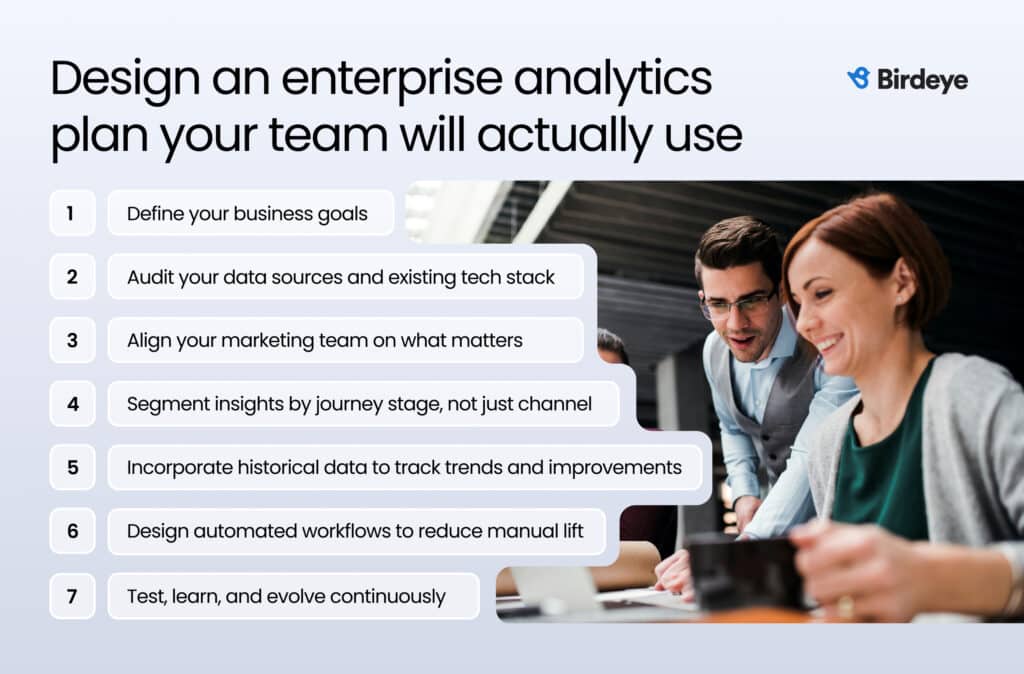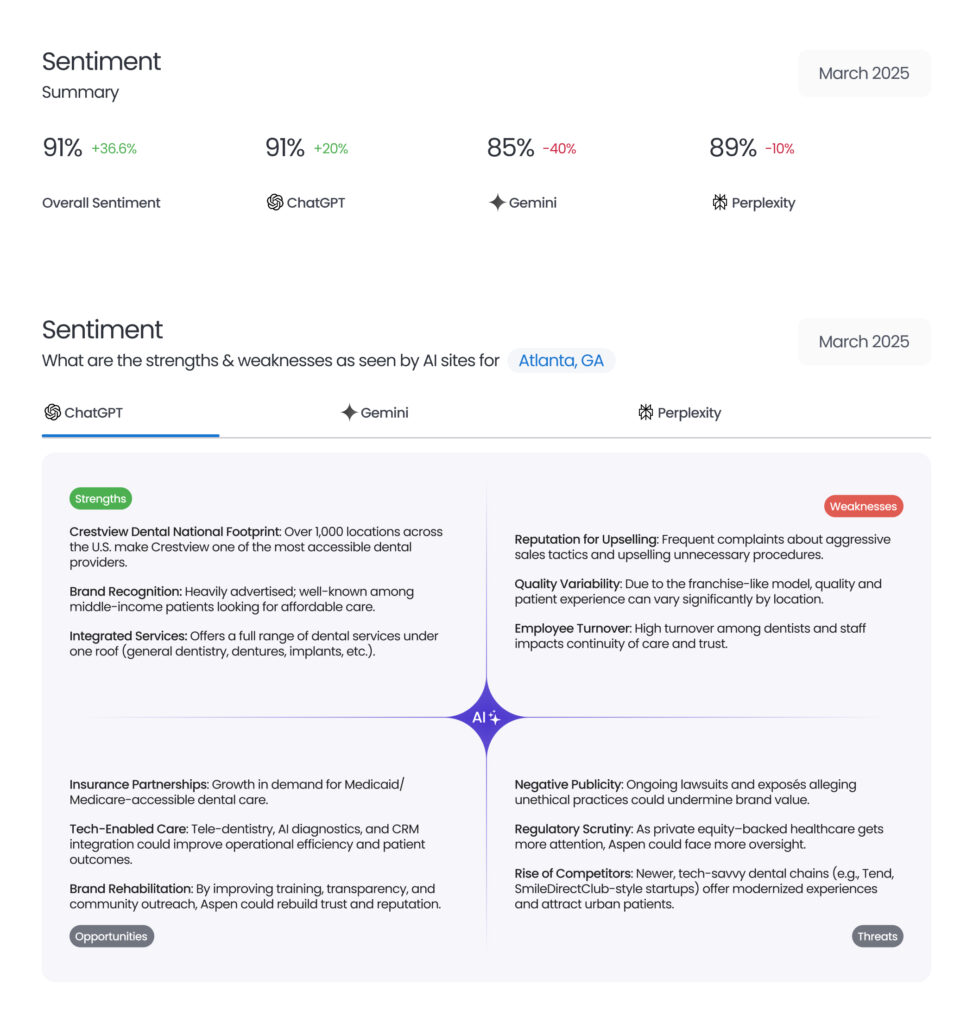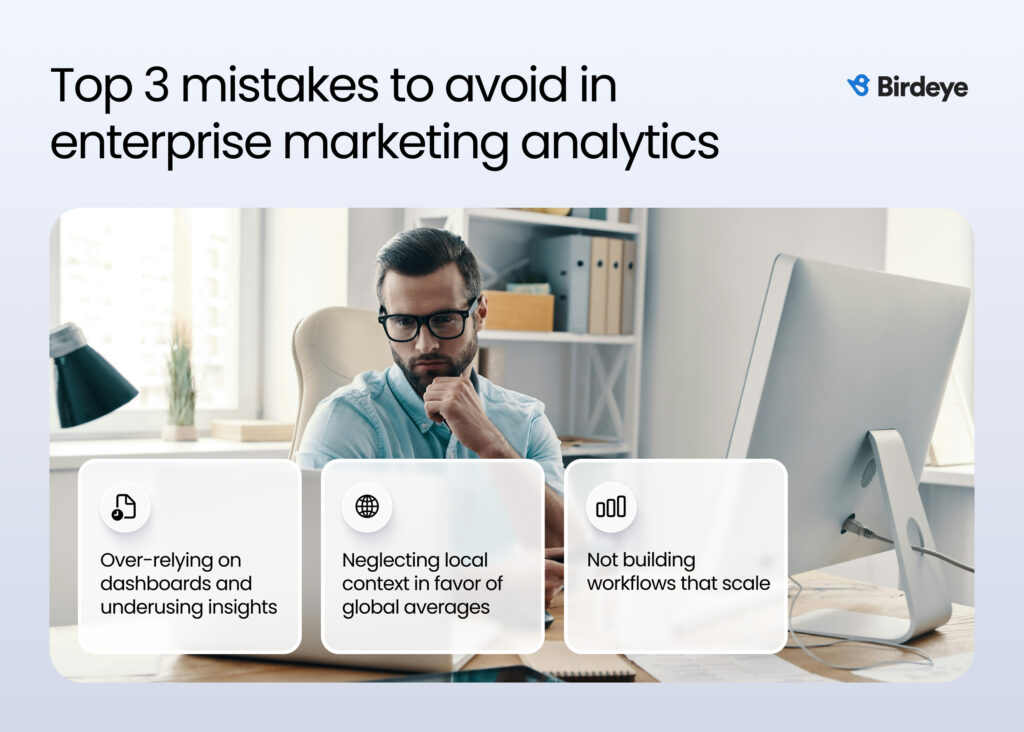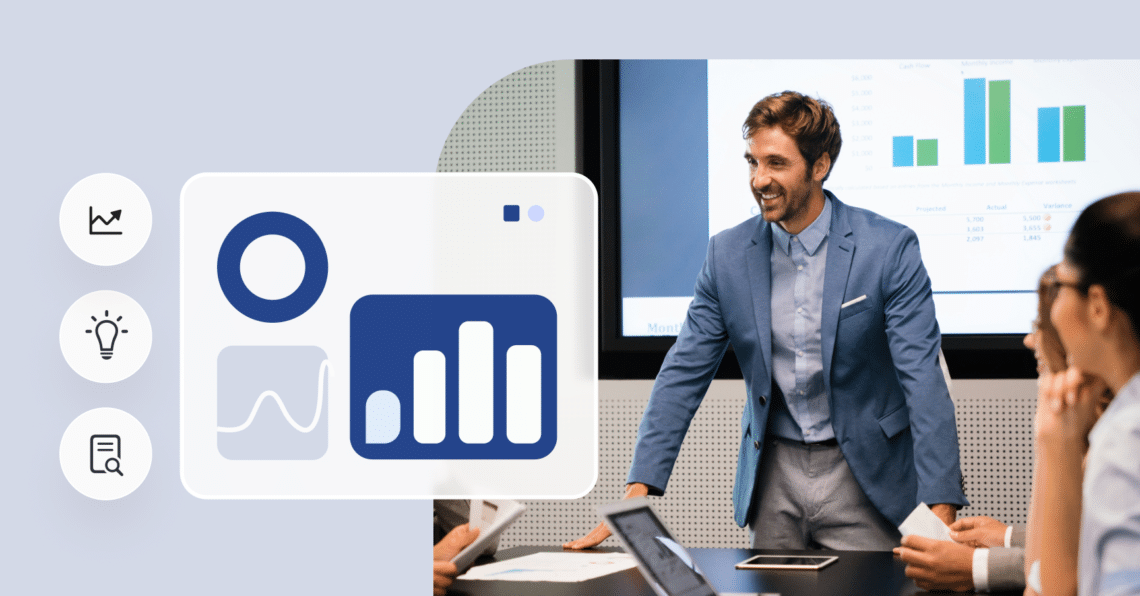Enterprise marketing analytics is the operating system for growth. It unifies data collection from search, social, CRM, and different marketing channels so your marketing team sees what works, what doesn’t, and what to do next, while honoring data privacy regulations.
Summary
Enterprise marketing analytics turns digital noise into decisions. In 2026, teams collect more data than ever but struggle to act. Leaders want outcomes, not overviews. A real enterprise stack structures signals across marketing channels, maps them to revenue, and gives the marketing team clear next steps. It goes beyond “what happened” to forecast results, surface missed opportunities, and align marketing team priorities with pipeline and profit. Think predictive models, governed data, and actionable insights tied to campaigns, customer behavior, reviews, and local performance.
Curious to learn how to build this capability and move from dashboards to decisions? Follow along for practical frameworks, playbooks, and measurement tips your marketing team can use to operationalize enterprise marketing analytics and win.
Beyond the dashboard 🖥️
Brands that succeed at scale aren’t just collecting numbers. They’re extracting actionable insights from every touchpoint: marketing campaign performance, customer behavior, review sentiment, and locations.
And it’s not just about what happened yesterday. With the right enterprise marketing analytics platform, teams can go beyond reporting and start predicting. They can model outcomes, surface missed opportunities, and align marketing with revenue.Table of contents
- What is enterprise marketing analytics?
- Why do enterprise businesses need marketing analytics to grow smarter?
- Choosing the right enterprise marketing platform starts with the right priorities
- Key features to look for in an enterprise marketing analytics platform
- How Birdeye GenAI helps you turn marketing signals into an enterprise analytics strategy
- Top 3 mistakes to avoid in enterprise marketing analytics
- FAQs about enterprise marketing analytics
- Birdeye: The enterprise analytics platform that ROI-driven brands favor
What is enterprise marketing analytics?
Enterprise marketing analytics is the process of gathering, unifying, and analyzing large volumes of marketing data across teams, locations, and marketing channels to understand what drives business results.
It gives enterprises the ability to assess their marketing efforts in real time, across multiple sources like review platforms, CRM tools, email, paid ads, and web traffic, all within a centralized analytics platform.
The goal isn’t just better reporting capabilities. It’s turning fragmented data into clear insights that support marketing campaigns, improve customer engagement, and inform smarter budget allocation.
At the enterprise level, it’s not enough to know what happened. You need to understand why it happened and what to do next. That’s where enterprise analytics connects the dots between activity and outcomes.

How is it different from traditional analytics?
Traditional marketing analytics tools often focus on individual channels or on fundamental metrics such as website visits or ad clicks. While that might work for small teams, enterprise-level organizations require more: a system that supports large datasets, layered teams, regional performance breakdowns, and rapid decision-making.
Here’s what sets enterprise analytics strategy apart:
- Integrating data from omnichannel communication touchpoints (reviews, ads, CRM, email, listings)
- Tracking user behavior and customer journeys across platforms and locations
- Performing data analysis at speed with advanced analytics tools
- Ensuring consistency and data privacy across thousands of locations
- Enabling teams to run attribution analysis, track key metrics, and measure marketing performance in a structured, unified way
An enterprise analytics platform helps you go beyond reactive reporting. It allows your marketing team to predict, and that shift changes everything.
Why do enterprise businesses need marketing analytics to grow smarter?
Marketing teams at enterprise scale face a unique challenge: the more campaigns you run, the harder it becomes to track what’s actually working. You’re juggling complex datasets, shifting marketing strategies, and varying results across locations, yet decision-makers still expect clarity, speed, and results.
Take National Storage Affiliates, for example. With over 1,100 self-storage properties across 42 states and Puerto Rico, their success depends on capturing real-time feedback, understanding regional trends, and reacting quickly to customer needs.
Their marketing team isn’t just focused on clicks or impressions. They’re using enterprise analytics to refine marketing strategies, personalize experiences, and continuously adapt based on what customers are actually saying.
Using Birdeye’s analytics platform, they combine customer relationship management data, review sentiment, and survey responses to spot gaps in service, map customer journeys, and improve campaign performance.
With tools like Birdeye Insights AI, they’re able to surface actionable insights by location, adjust rate increase strategies based on real-time sentiment, and uncover churn signals before they become a problem.
Their strategy reflects what more enterprise-level organizations are starting to realize: surface-level reporting doesn’t cut it anymore. Teams need deeper insights, structured escalation processes, and the ability to quickly act on feedback.
With support from Birdeye’s GenAI tools, National Storage Affiliates has transformed how it does customer behavior analysis, resolves complaints, and scales consistent, personalized experiences.
Choosing the right enterprise marketing platform starts with the right priorities
By now, it’s clear that enterprise analytics strategy is more than performance tracking, but about converting customer behavior into decisions that move your business forward. But here’s the challenge: many teams still rely on tools that were built for siloed data and simpler marketing strategies.
To keep pace with shifting customer journeys, rising expectations, and fragmented data sources, your platform must guide, not just report. Choose an enterprise digital analytics solution and an enterprise marketing reporting platform that captures historical trends and helps you uncover trends across channels. It should also model future outcomes, so your marketing team can think bigger, act faster, and deliver real impact.
Key features to look for in an enterprise marketing analytics platform
Not all enterprise marketing analytics tools are designed for enterprise scale. If you’re managing data across regions, teams, and customer segments, your platform needs to do more than just display metrics — it must help your team extract meaning and make decisions faster.
Here are the key features that matter most in an enterprise analytics platform:

1. Centralized visibility across all data sources
Your platform should unify customer data from CRM, surveys, listings, ads, and web traffic — whether you’re using Google Analytics, Google Data Studio, or a proprietary dashboard. Without this, you’re left chasing insights across disconnected systems.
2. Built-in intelligence that helps you analyze, not just observe
Great analytics tools don’t stop at metrics. They help teams analyze data, uncover friction in the funnel, and identify drop-offs in customer journeys. This is how enterprise teams gain clarity on what’s driving (or blocking) customer engagement.
3. Role-based dashboards for a distributed marketing team
Your marketing team doesn’t need a wall of charts. They need tailored views that align to business goals, campaign performance, and team objectives — all without requiring teams to rebuild from raw data.
What Makes Birdeye the Right Fit for Enterprise Marketing Analytics
Want to see the impact of Birdeye on your business? Watch the Free Demo Now.
4. Support for advanced workflows and automation
As users engage across omnichannel touchpoints, set automated triggers, personalize email marketing journeys, and route actions to the right owners. Anchor this in an enterprise analytics strategy so sequences adapt as visitors interact, with API-driven handoffs and integrations that work at Fortune 500 scale.
5. Predictive modeling and future-ready analytics
Use enterprise digital analytics to forecast future outcomes. Apply data mining to sentiment, model ROI scenarios, and detect leading indicators early, allowing marketers to act before trends harden.
6. Customization and scalabilty without complexity
Choose an enterprise marketing platform that supports flexible tagging, reusable templates, and permissions by business unit or region. Pair it with an enterprise marketing reporting platform built for compliance, API access, and integrations so teams grow with scalability and keep a complete view of performance.
7. Visual, collaborative, and secure
Adopt real-time data visualizations and collaborative workspaces that protect data with strong security and governance. Native integrations with Google Ads, web analytics, CRM, and internal reporting systems give stakeholders a single, consistent view, enabling marketers to move from insight to execution quickly.
Pro tip: A good enterprise analytics strategy doesn’t just tell your marketing team what’s happening. It tells them how to respond, making action easy, measurable, and your competitive advantage.
How Birdeye GenAI helps you turn marketing signals into an enterprise analytics strategy
Too many enterprise teams mistake access for insight. Just because the data is available doesn’t mean it’s usable. Without a way to connect performance signals across locations, channels, and tools, what you end up with isn’t clarity — it’s a backlog of unanswered questions.
Birdeye’s GenAI tools are built to change that: not by showing more, but by showing what matters.
Let’s walk through how each tool drives enterprise marketing analytics forward, with real examples and product-backed capabilities.
Insights AI: See the full picture
Insights AI brings together reviews, SEO signals, and survey data into a centralized view of user behavior and brand perception. With smart filters, interactive dashboards, and location-based comparisons, teams can finally stop toggling between tools and start making data-driven decisions.
Want to know which regions underperform in sentiment? Or which product lines are triggering complaints? Insights AI delivers that in seconds — with AI-powered summaries and predictive analytics to show what’s coming next.
Listing AI for enterprise marketing teams: make sure customers find you first
Visibility is the blind spot in many analytics platform rollups. If listings are inaccurate, even enterprise-level companies get buried in local search. Listing AI audits every field in your profiles, compares against customer preferences, and recommends precise fixes that improve discoverability. It helps marketing teams identify trends by location and category, so you can prioritize what moves results.
Push updates across hundreds of profiles in a few clicks. Built for Fortune 500 needs, Listing AI supports compliance, deep integrations, and true scalability. Google, Apple, Facebook, and Bing stay current with your latest services, hours, attributes, and Q&A. Track keyword rankings, assess Google Business Profile completeness, and monitor real-time performance to optimize faster and expand your local SEO footprint.
Search AI: Get your brand cited in AI answers
Birdeye Search AI helps your brand appear in ChatGPT, Gemini, Perplexity, and more. See real prompts, where you show up, what each AI says, and which citations they trust. Audit business details, track share of voice and sentiment, and benchmark performance by topic, location, and competitor.
Need action, not just insights? Search AI suggests and publishes content tuned for answer engines to close gaps. The Search Optimization Agent, in early access, proposes one-click fixes for approval. Connect with Google Analytics, Search Console, or your CRM to tie AI visibility to traffic, leads, and revenue.

Reviews AI: Turn customer voice into your competitive edge
Reviews AI helps your marketing team scale online reputation efforts without scaling headcount. Automatically request, respond to, and analyze reviews across 200+ sites, using on-brand responses, auto-translation, and even review-based social posts.
Need to analyze trends across thousands of reviews? AI-generated summaries highlight sentiment, recurring themes, and outliers across regions.
You can segment by user interactions, star rating, location, or keyword, and get advanced analytics to inform your marketing campaigns.
When paired with Google Analytics or other tools in your existing tech stack, Reviews AI adds the “why” behind the numbers.
Competitors AI: Benchmark your brand, location by location
Your team doesn’t need more data. It needs to know how you stack up.
Competitors AI gives you that view by monitoring competitors’ reviews, social content, and visibility scores. You can benchmark key features like sentiment, star ratings, and audience growth, and spot where you’re falling behind or leading.
This visibility helps you allocate resources more strategically and automate workflows for recurring insights.
It’s not about copying competitors, it’s about beating them where it matters.
Let’s see how Moss & Company personalized its experiences for hundreds of locations.
How Moss & Company gained actionable insights across 300+ locations
Moss & Company, a property management brand with 300+ locations and 14,000+ rental units, needed more than just a review tracker; they needed an enterprise marketing platform that could help them understand residents and act fast.
With Birdeye Listings AI, they ensured every property’s information was accurate and up-to-date across channels, leading to a:
- 761% increase in map views
- 290% increase in website visits
- 222% rise in direction requests
Using Birdeye Reviews, they centralized all feedback, responded to 141% more reviews, and saw a 62% jump in review volume.
The review dashboard empowered them to sort by sentiment, source, and time period — giving them valuable insights without the manual lift.
With Birdeye Insights AI, Moss identified property-level issues — from amenities to maintenance — and used detailed reports to guide team performance. They no longer had to rely on periodic check-ins; they had always-on analytics tools surfacing what mattered most.
The result? Better training, faster escalations, and smarter marketing analytics grounded in real data.
Top 3 mistakes to avoid in enterprise marketing analytics

Getting started can feel noisy with various platforms, metrics, and requests from internal stakeholders. Most setbacks are pattern mistakes you can fix quickly with the right enterprise analytics strategy.
1) Over-relying on dashboards, underusing insights
- Problem: Beautiful, intuitive dashboards that no one acts on. Teams track performance for website traffic and conversion rates, yet outcomes stall.
- Fix: Pair enterprise digital analytics with decision playbooks. Use an enterprise marketing reporting platform to push next steps to owners through API workflows and integrations so insights consistently drive action at scale.
2) Ignoring local context for global rollups
- Problem: Averages hide market realities and location outliers.
- Fix: Compare markets side-by-side in your enterprise marketing platform. Segment by region, service line, and channel to surface outliers, then route actions to field teams. This approach supports compliance and Fortune 500 governance requirements.
3) Building insights without scalable workflows
- Problem: Findings live in slides, emails, or spreadsheets with no owner and limited follow-through.
- Fix: Operationalize analytics with a governed enterprise marketing reporting platform built for scalability. Automate alerts, assign owners, and schedule rollups across various platforms. Connect to CRM and ad systems via API so successful playbooks repeat.
What “good” looks like
- A documented enterprise analytics strategy that links metrics to owners and SLAs.
- Platform foundations that include enterprise digital analytics, cross-channel modeling, and compliance-ready lineage.
- Execution that lifts conversion rates through real-time routing, strong integrations, and consistent action.
FAQs about enterprise marketing analytics
Unlike basic tools that track clicks or web traffic, enterprise marketing analytics connects channels, shows what moved results, and suggests next steps. You can track website performance, see how content marketing lands, and share custom reports in an accessible format so leaders can make data-driven and informed decisions that improve customer experiences.
Pick a platform that unifies data, automates actions, predicts outcomes, and integrates with CRM, Google Analytics, and review sites. Birdeye provides multi-location teams with clear insights, custom reports, and workflows that support everyday marketing activities.
It turns scattered signals into clear actions your team can trust. Enterprise digital marketing analytics uncovers local patterns, links work to revenue, and guides smarter content marketing, leading to better customer experiences and more data-driven decisions.
AI transforms analytics from static dashboards into intelligent systems. With capabilities like predictive analytics, sentiment detection, and GenAI summaries, platforms like Birdeye help teams surface what matters most, automate feedback loops, and act faster across every channel.
Instead of tracking everything, focus on the metrics that tie back to business outcomes — like review sentiment, keyword visibility, conversion rates, customer churn signals, and journey drop-offs. The best enterprise marketing analytics software helps surface these insights by region, campaign, and channel.
Enterprise analytics adds governed data models, access controls, and actions. An enterprise marketing platform executes your enterprise analytics strategy across teams and marketing tools via APIs and integrations.
Stream events, micro-batch where needed, and use a semantic layer for enterprise digital analytics. Your enterprise marketing reporting platform should scale horizontally, track lineage, and monitor customer behavior and customer satisfaction in near real time.
AI turns noise into next steps: anomaly detection, churn prediction, and simple-English insights for marketing strategy. It recommends analytics solutions and automates actions through API workflows, without breaking compliance.
Unify listings, reviews, and web data in enterprise analytics. Correlate updates in search engine optimization with calls, visits, and revenue; prioritize fixes; and report outcomes to leadership, closing the loop inside your enterprise marketing platform.
Birdeye: The enterprise analytics platform that ROI-driven brands favor
Enterprise marketing analytics focuses on understanding customer feedback, spotting execution gaps, and fixing them fast. It aligns data from different channels to revenue outcomes with real-time dashboards and a clear enterprise analytics strategy. With governed data and a shared semantic layer, enterprise digital analytics shows cause, effect, and the next best action leaders can trust.
Birdeye is an AI company and an agentic enterprise marketing platform trusted by 200,000+ businesses, with 3,000+ integrations for seamless workflow automation. AI agents automate reviews, listings, social, and surveys. At the same time, the enterprise marketing reporting platform connects data from the web, reviews, and Google products to outcomes such as calls, bookings, and click-through rate, allowing teams to see what works and scale it.
- Real-time visibility across locations
- Smart recommendations, not just metrics
- Enterprise-grade reporting, automation, and security
Ready to see what smarter marketing looks like?

Originally published









